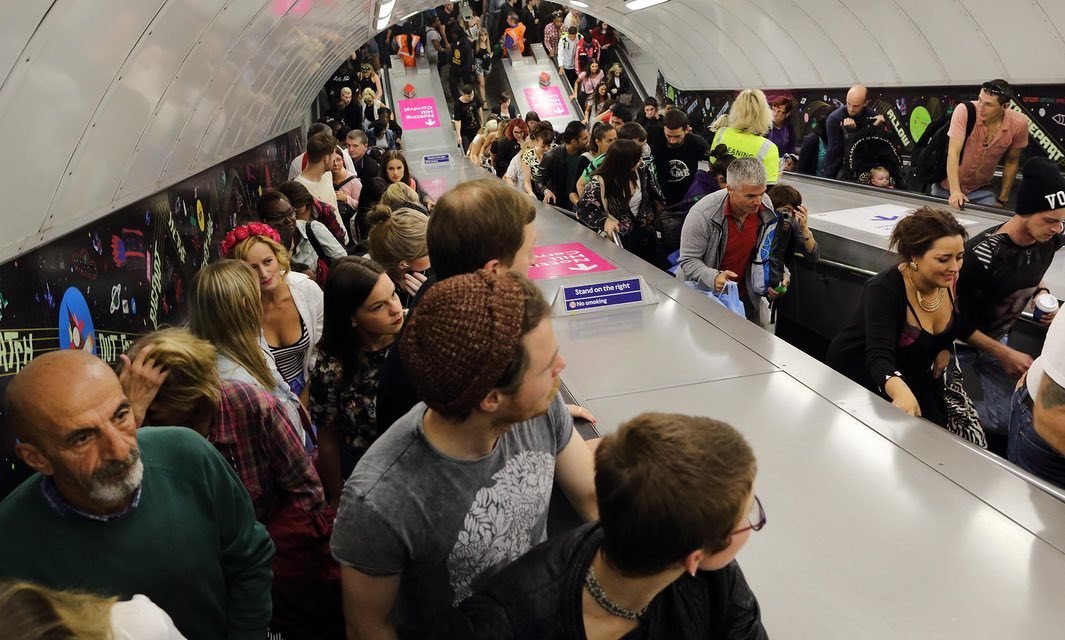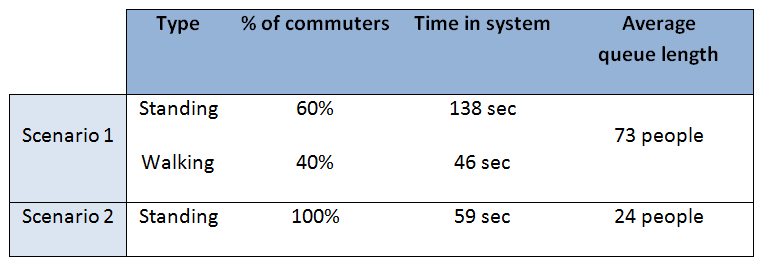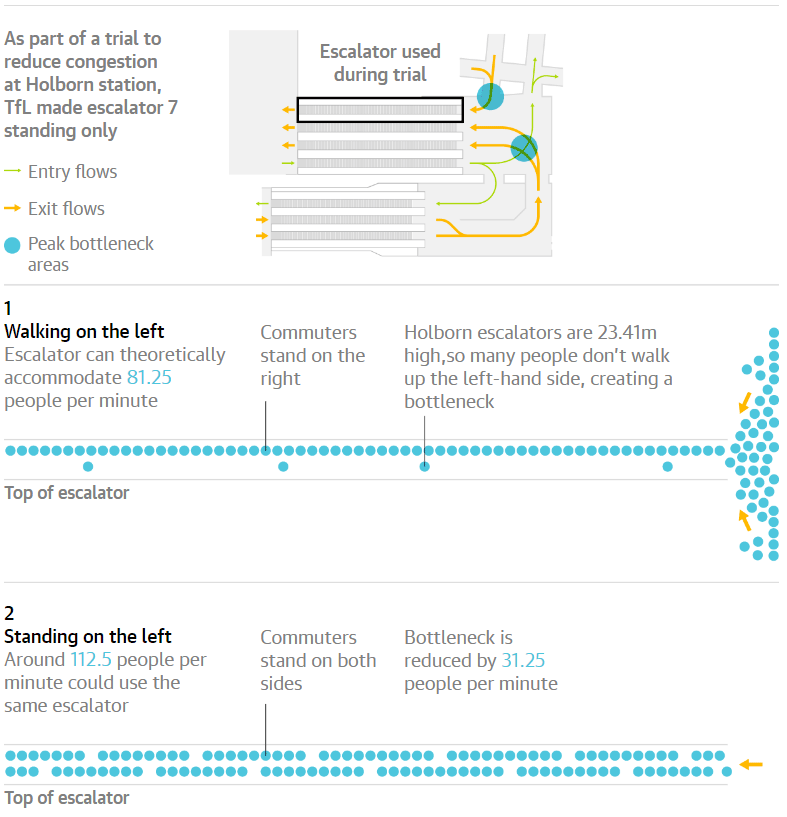Escalator

From 8:30 to 9:30 on Friday angry passengers of the extreme escalator at Holborn station of the London Underground Forced to become in both rows
People who walk along the escalator in the left row, save a few seconds. But experts have long found out that this is not the optimal loading of the escalator. Its capacity is drastically increased if all passengers are in two rows.
According to a study by the University of Greenwich in 2011, approximately 75% of passengers are on the escalator in the right row, and 25% are on the left. Already from these figures, the nonsense of such behavior is understandable. In the metro of Tokyo and Hong Kong long understood this and for years accustomed passengers to stand in two rows. Employees of the London Underground in 2016 conducted a six-month experiment on real passengers of one of the busiest stations in Holborn, forcing them to change such harmful behavior, which causes a crowd at the entrance to the escalator, slowing the transportation of people and deteriorating security in the metro
For the London Underground the problem is very urgent. Opened in 1863, now it has grown to 270 stations and carries millions of passengers a day. December 4, 2016 was set a record: 4,821,000 passengers in one day. The annual passenger traffic exceeds 1.3 billion people. In Europe, the London Underground is inferior only to Moscow and Paris in this respect, so Moscow subway workers should carefully consider this research of their English colleagues.
The idea of changing the usual behavior of the passengers meters came to one of the British specialists after traveling to Hong Kong. There he noticed that all people calmly get on the escalator in the subway in two rows – and as if the passenger traffic seems more efficient. The specialist reported on his observation to colleagues – and they decided to test it.
First, a computer simulation was created for the Green Park station (in open bases there are models of passenger traffic on different types of transport). She showed that the ascent of the escalator takes 26 seconds on foot, the rise standing in the right row is 40 seconds, and 40% of passengers prefer to go in the left row. At the same time the left side misses a maximum of 70% of the passengers who are on the right side, because each person takes on average two steps, and each walker takes four steps .
Then, a simulation of two different Scenarios. In the first scenario, the “real situation” was described, when 60% are on the escalator, and 40% are on. And in the second scenario both rows of the escalator were occupied by standing passengers. It was found out that in the first case the waiting and lifting time for standing and walking passengers took 138 and 46 seconds, respectively. And in the second case – 59 seconds for everyone. That is, for 60% of passengers, the lifting time is reduced by 79 seconds, and for 40% of passengers – increases by 13 seconds. The average turn before the escalator is reduced from 73 to 24 people.

That is, it is unambiguous that moving along the escalator standing on both sides is beneficial – the average time of ascent is significantly reduced. Those who used to walk lose only 13 seconds, but do a great service to other passengers if they stand. The turn in front of the escalator decreases significantly, which reduces the crush, improves safety, improves passenger comfort (does not need to crowd in the queue), and increases the escalator’s throughput.
A three-week experiment was conducted at the Holborn station in the London Underground in 2015 2016 – a six-month experiment that confirmed the assumptions. During the experiment, one of the seven escalators was forcibly made two-row.

Comparison of single-row traffic at different stations showed that passengers in the right row are on every second step, and passengers in the left row Go for every fourth, because of which space on the escalator is used irrationally.
At the same time on long escalators, as at the station Holborn, a much smaller number of passengers prefer to go in the left row. Here the escalator has a length of 23 m 41 cm, so that few people go to the left, and some even stand, creating traffic jams.
Experts understand that changing the generally accepted rules will cause discontent of passengers. Actually, the experiment at the Holborn station has already confirmed this. People are used to suboptimal behavior – to stand on the right and leave an empty bar on the left for those who are in a hurry. This is a tradition. Those who block the way to the left, even sometimes subject to obstruction, they make comments and shame. “Passengers simply do not like these things to change,” said Celia Harrison, an analyst for passenger traffic strategy for the state transport organization Transport for London, and one of the key experts who promotes a “heretical” change in the rate of movement on escalators. – I worked at the stations for many years. And I know that whatever we do, people feel uncomfortable when we interfere with the standard routine. ”
The experiment at Holborn Station fully confirmed the results of the simulation: the passenger flow on the double-row escalator was significantly higher. During the hours of the experiment, the escalator carried 16,220 passengers per hour instead of the standard 12,745. Nevertheless, people took the bayonets of the employees who directed the traffic. In the first three weeks, as soon as he was not called an experiment: “terrible”, “crazy”, “idiotic”, “funny” and “very bad idea”. 18 people called him “stupid”. The employee who organized the movement on the escalator to Holborn said that one of the passengers even showed him the middle finger.
There’s nothing to be done, people’s habits are sometimes stronger than common sense. But the experience of Hong Kong and Tokyo shows that passengers can still be taught to correct behavior, although the change of habits will take a long time.








